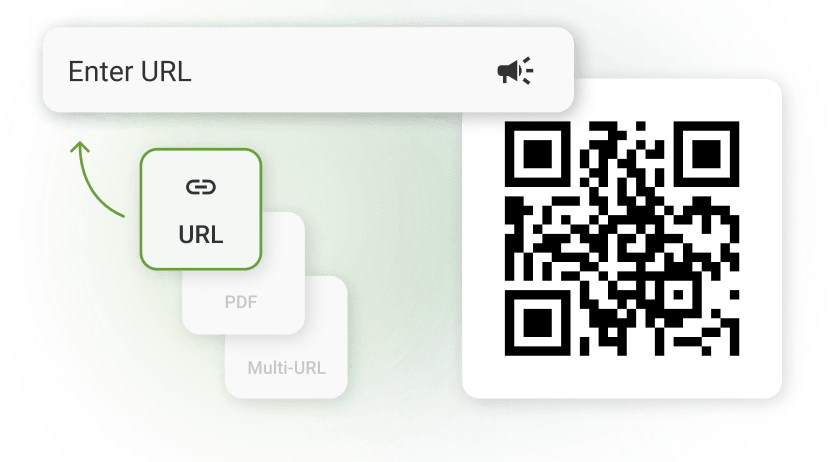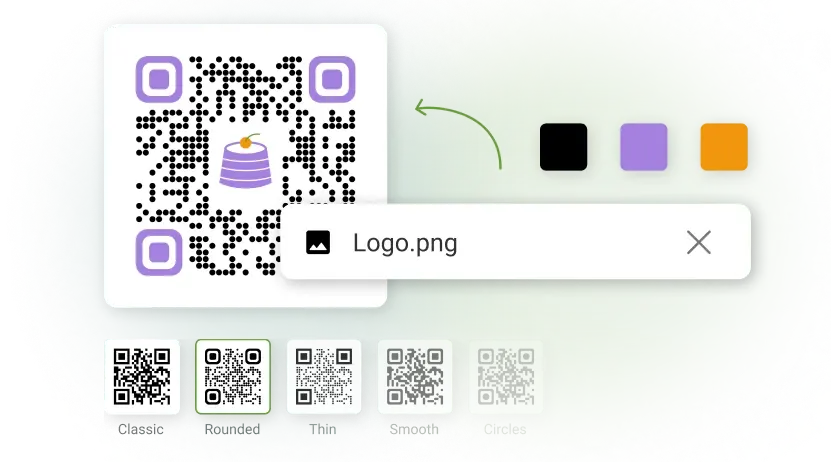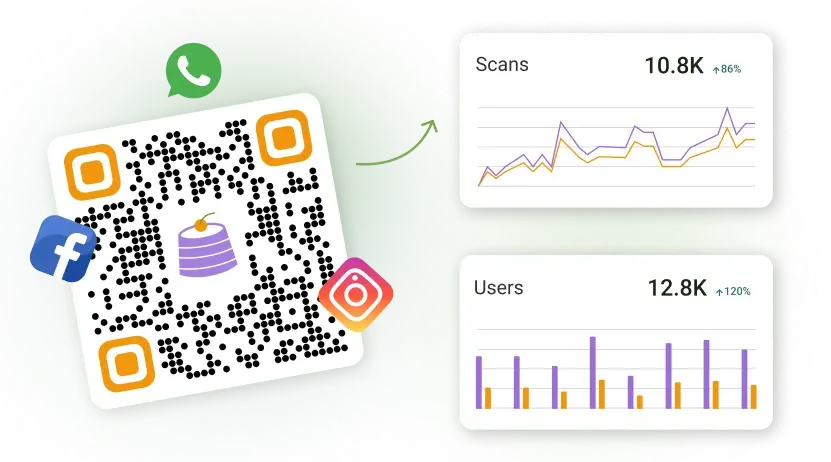The difference between sharing a little information and a lot depends on how much data a QR Code can hold.
Regular QR Codes are great for basic things, like linking to a website or showing a short message. But standard QR Codes hit their limit when a pharmaceutical company needs to fit much more product data on a tiny medicine bottle label.
Today’s businesses need to embed more data, and that’s where iQR Codes come in.
iQR codes handle the complexity that standard codes simply cannot manage. This could be information on shipping labels or even retail tags.
The result is more intelligent labeling that serves both businesses and consumers better.
Table of Contents
- What is an iQR Code?
- How does iQR Code Work?
- Key Differences Between iQR Code and Standard QR Code
- Where can iQR Codes be Used?
- How to Create iQR Codes
- Best Practices to Follow While Deploying iQR Codes
- Is iQR Code the Right Choice for You?
- Frequently Asked Questions
What is an iQR Code?
An iQR Code is an upgrade on standard QR Codes designed to handle more data in less space. It stores up to 80% more data than standard QR Codes in the same space. Developed by Denso Wave, iQR Codes are rectangular in shape. It can hold 40,000 numeric characters compared to QR Codes’ 7,089.
Think of it as a QR Code’s more capable sibling. Standard QR Codes max out at storing a URL and basic text. iQR Codes handle entire product catalogs, multi-language instructions, and complex tracking data. All in a space smaller than your thumbnail.

You might wonder, what’s inside an iQR Code that makes it more powerful? Let’s break it down.
How does iQR Code Work?
At first glance, an iQR Code looks a lot like a regular QR Code. But behind the scenes, it’s built to be smarter and more flexible.
Here’s how:
- More data in less space: iQR Codes can hold much more information than standard QR Codes, up to 80% more. You can fit long text, multiple links, or detailed data into a smaller space. For example, a medicine bottle label that can fit a 15mm QR Code can store dosage instructions, contraindications, and tracking information with a 15mm iQR Code.
- Flexible shape: Most QR Codes are square, but iQR Codes can be square or rectangular. The rectangular format adapts better to narrow or curved surfaces. Think wristbands, product labels, and tags where space is limited. You can also create codes that are 5×95 modules or 15×15 modules. This makes them ideal for small items such as electronics or jewelry.
- Stronger error correction: iQR Codes handle damage, dirt, or printing mistakes better. It uses advanced Reed-Solomon error correction. This means even if 50% of the code is scratched, smudged, or partially covered, the code still scans reliably.
- High-speed scanning: iQR Codes are easier and faster for scanners to read, even when printed tiny or placed at an angle.
Real-world example: A Japanese electronics manufacturer switched to iQR Codes for its circuit boards. The result? 60% space savings while adding serial numbers, manufacturing dates, and quality control data.
Key Differences Between iQR Code and Standard QR Code
Here’s how iQR Code compares to standard QR Codes:
| Feature | iQR Code | QR Code |
| Data capacity | 40,000 numeric / 13,000 alphanumeric | 7,089 numeric / 4,296 alphanumeric |
| Shape options | Rectangle or square | Square only |
| Error correction | Up to 50% | Up to 30% |
| Minimum size | 9×9 modules | 21×21 modules |
These technical advantages translate into real-world solutions across multiple industries. Let’s look at how businesses are putting iQR Codes to work.
Where can iQR Codes be Used?
iQR Codes are useful across many industries, here’s how five key sectors make the most of them:
1. Marketing: Campaign tracking
Marketing teams often rely on trackable QR Codes to measure the success of ads and promotions. But regular QR Codes sometimes fall short. They can’t hold long URLs with UTM parameters, and marketers often need to use redirect tools just to make them work.
iQR Codes solve this problem by allowing complete, uncut URLs with tracking tags to fit inside the code itself, no redirect services needed. This means less chance of broken links, faster page loads, and cleaner tracking data.
Real-world use: A clothing brand prints iQR Codes on in-store posters. Each code links directly to a campaign landing page, including source and location data. When customers scan the code, they’re taken straight to the right page, no extra steps, no waiting.
2. Healthcare: Asset tagging
Hospitals need fast, reliable access to equipment data. With regular QR Codes, space and durability can be a challenge. iQR Codes offer more storage and better error correction, making them perfect for medical environments.
An iQR Code can store the tool’s service history, operating instructions, and even a maintenance log, all in one small label. And because iQR Codes are harder to damage, they stay scannable even after frequent cleaning with harsh disinfectants.
Real-world use: A nurse scans a code on a defibrillator. In seconds, they see when it was last checked, when it needs servicing, and how to use it in an emergency with no manual needed.
3. Events: Smart ticketing
Event organizers often need to manage tickets, seating, access levels, and guest preferences all at once. iQR Codes can hold all this information in a single, compact code.
Because iQR Codes can be rectangular, they fit easily on badges or wristbands. And they still scan even if they’re slightly bent, scratched, or covered.
Real-world use: An attendee walks into a conference with a badge. One scan reveals their name, meal choice, access to breakout sessions, and any special needs. No juggling multiple passes as everything’s in one place.
4. Retail: Mini labels
Pharma and electronics companies use iQR Codes where space is tight. Some products, such as pills or tech gadgets, come in tiny packages. There’s often not enough room to print instructions, safety information, or extra details. iQR Codes solve this by packing much more into a smaller space.
A 10mm iQR Code on medication packaging can include:
- Dosage in three languages
- Drug information and expiration
- Batch number and adverse reaction links
Real-world use: A customer picks up a box of cold medicine. They scan the small code and instantly see dosage instructions, allergy warnings, and a short video explaining how to take it safely.
5. Logistics: Supply chain tracking
In shipping, every second counts. Workers often juggle packing slips, customs forms, and tracking labels. With iQR Codes, all this data can be stored in one scannable label.
And because iQR Codes can be rectangular, they fit neatly alongside barcodes and other standard shipping information.
Real-world use: A warehouse worker scans a box. The code reveals the tracking number, handling instructions, customs documents, and delivery schedule with no extra scanning or paperwork required.
You’ve seen the benefits of using iQR Codes in real situations. The good news? Making one is easier than you might think.
How to Create iQR Codes
Creating iQR Codes requires a QR Code generator that supports the format. Most mainstream QR Code platforms currently do not support iQR Code generation. However, the following businesses can help you with that:.
- Denso Wave: The inventor of iQR Codes offers official development tools.
- TEC-IT Barcode Studio: A commercial barcode software with iQR support.
- BarTender by Seagull Scientific: An enterprise-level label software.
- Zint Barcode Studio: Open-source and supports iQR Codes.
These tools are mostly desktop-based. Very few purely web-based generators support iQR Code. Also, verify scanner compatibility when deploying iQR Codes in public-facing applications.
After you’ve selected the service provider, the process of creating iQR Codes would involve:
Step 1: Choose your data
Decide what information to store:
- Full URLs with tracking
- Product specifications
- JSON structures
- Contact details
Step 2: Configure shape and size
Choose based on use case:
- Square (15×15) for general use
- Narrow rectangle (5×95) for wristbands
- Wide rectangle (25×15) for packaging labels
Step 3: Select error correction level
Choose based on the environment:
- Level L (7%): Controlled environments
- Level M (15%): General use
- Level Q (25%): Outdoors
- Level H (50%): Harsh conditions
Step 4: Generate and test
Create the code and test it with various scanners and devices. Then, test it on actual surfaces at the intended print size. Once your iQR Code is generated and passes initial testing, it’s time to focus on deployment.
Following these best practices will ensure your code performs reliably across different environments and scanning conditions in the real world.
Best Practices to Follow While Deploying iQR Codes
As you deploy iQR Codes at scale, aligning with technical and legal best practices becomes essential. Poor contrast, sizing issues, or insufficient quiet zones can lead to scanning failures. Likewise, failure to comply with privacy regulations can erode trust or result in penalties
Follow these practices to avoid post-deployment troubles.
Compliance and privacy considerations
When encoding personal or sensitive data:
- Encrypt information if needed
- Link to a privacy policy
- Follow GDPR and CCPA rules
- Control access to scanned content
Limitations and compatibility
Despite its advantages, iQR Code has some constraints:
- Reader support: Not all scanners recognize iQR Codes. Test with devices your audience is likely to use.
- Print limitations: Each module must be at least 0.33mm in size to ensure accurate scanning. Poor contrast can also cause scan failures, so aim for a minimum 4:1 contrast ratio between the code and its background. A quiet zone, blank space around the code of at least two modules, is required. Color choice matters too: avoid red or orange on white, as many scanners struggle to detect those combinations.
- Data privacy: The more data you store, the greater risk you take. Protect sensitive data with encryption and limit what’s stored in the code.
Is iQR Code the Right Choice for You?
Standard QR Codes are the go-to solution for most everyday applications. They work with almost every QR Code scanner and are perfect for linking to websites, sharing contact details, or displaying short text snippets.
If you need to store more data, like detailed documents, high-quality images, or large datasets, QR Codes are a better option. But there is a catch: not all scanners can read them, especially older or basic scanners (like mobile devices). So, they’re best for controlled environments with the right scanning tools, such as factories, warehouses, or technical equipment.
For the best of both worlds, broad compatibility and the ability to manage larger amounts of data, consider Dynamic QR Codes. They appear as standard QR Codes to any scanner and act as a ‘pointer’ to online content. This means you can change the destination information (like a URL) after the code is printed, and track scan analytics. They’re perfect for marketing, events, or any project where you want to track results and stay flexible.
Sign up to create your free dynamic QR Code now and see how The QR Code Generator helps optimize every scan.
Still have questions about using iQR Codes effectively? Let’s tackle some of the most common ones to help you confidently move forward.
Frequently asked questions
Many modern QR Code scanners support iQR, but compatibility varies. Therefore, always test across various devices and network settings.
Up to 40,000 numeric, 13,000 alphanumeric characters, or 5,500 bytes of binary data. It is roughly equivalent to:
– A short novella (around 10–15 pages of plain text)
– Over 100 full contact vCards
– Dozens of product SKUs with metadata
– A full-page product label with instructions in multiple languages
– A compressed file containing images, PDFs, or documents (when encoded as binary)
iQR Codes are secure as they support encryption and access controls. You can also embed security tokens and authentication data to ensure enterprise-grade security.







